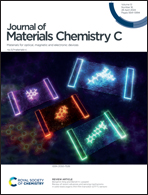Optimizing high-efficiency multiple resonance blue delayed fluorescent emitters through charge transfer excited state tuning†
Abstract
Highly efficient blue multi-resonance thermally activated delayed fluorescence emitters with narrowband emissions based on an oxygen-bridged boron framework are crucial for next-generation full-color displays with high color purity. In this work, we develop a simple molecular design strategy for D–A type MR materials based on the modulation of the donor rigidity. Two novel oxygen-bridged boron MR-TADF materials, DPC and DTP, show blue emissions with sharp peaks at 458 nm and 470 nm, with small full-width at half-maximum (FWHM) bandwidths of 44 nm and 50 nm, respectively. The corresponding organic light-emitting diodes (OLEDs) based on DPC and DTP exhibit maximum external quantum efficiencies (EQEmax) and power efficiencies (PEmax) of 38.6% and 28.1%, 59.6 lm/W and 58.6 lm/W respectively. This strategy provides a simple method to extend the structural diversity of highly efficient TADF emitters, optimize optoelectronic properties, and establish the correlation between delayed fluorescence lifetime and the charge transfer states in TADF devices.



 Please wait while we load your content...
Please wait while we load your content...